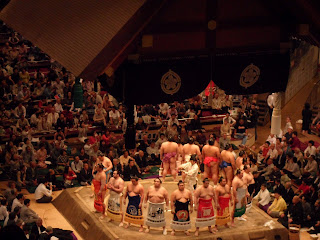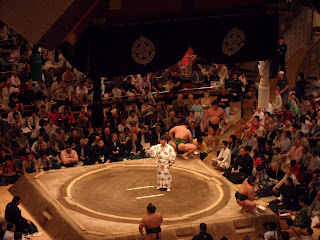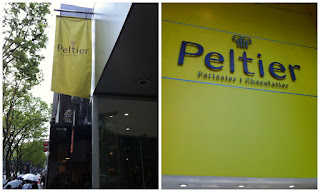The Sumo Tournament: The Grand Sumo Tournament lasts for 15 days and the winner of the tournament receives the Emperor's Cup. The winner of the tournament is the wrestler with the best record of wins over losses (must have won at least 8 of his 15 matches).
Sumo Ceremonies/Rituals: If you've ever watched a sumo tournament or even just a single match, you will have seen the various ceremonies and rituals that take place, but you may not necessarily know what they mean.
- Dohyo-iri (Maku-uchi) This is the "entering the ring" ceremony that occurs immediately before the maku-uchi matches. The wrestlers for each side (east and west) of the maku-uchi enter the arena seperately in reverse order of rank wearing colorful ceremonial aprons.
 |
| Maku-uchi of the East entering the dohyo |
- Dohyo-iri (Yokozuna): The Yokozuna enters last and is attended by a senior gyoji and two other wrestlers. The Yokozuna then peforms the traditional dohyo-iri ceremony.
 |
| Yokozuna Hakuho entering the dohyo |
 |
| Hakuho performing the dohyo-iri ceremony |
- Water - After entering the dohyo, the wrestlers go through a series of symbolic movements. In order to cleanse the mind and body, the wrestler rinses his mouth with water and wipes his body with a towel. The wrestlers also go through a series of other movements such as raising their arms to the side, stamping their feet and slapping their body (to ward off injuries).
- Shiomaki - The wrestlers scatter a handful of salt to purify the ring and insure against injuries.
- Chiri-o-Kiru - The wrestlers squat on their toes and face each other in the ring and open their arms wide to show that they respect fair play.
- Sonkyo - Toeing the mark position (also includes glaring at each other).
- Shikiri - The wrestlers squat facing each other in a "get set" position using their fists to support themselves. At this point, the match usually doesn't start right away; rather, the wrestlers can go back to their corners and repeat the process (from shiomaki on). They have 4 minutes to complete this process and at the end of the 4 minutes, they must start the match. Repeating the process is considered a psychologial thing for the wrestlers to mentally prepare and it also serves to stir up the crowd.
- Tachi-ai - The initial clash.
- Torikumi - An initial charge by a wrestler toward his opponent.
Yokozuna's Match: The Yokozuna's match is always the last regulation match. Hakuho lost his final match and ended the tournament with a 10-5 record.
Emperor's Cup: Often, the winner of the tournament will already be known by the end of the second to the last day based on the wrestlers' records. However, we got lucky because the winner had not been decided the day before and in fact there were actually 3 wrestlers in contention for the Emperor's Cup depending on what happened in their regulation matches (Tochiozan, Kyokutenho and Kisenosato). Tochiozan did not have to wrestle because his opponent withdrew due to injury so he just waited behind the scenes to see whether he would win the Emperor's Cup outwright (based on his record) or whether he would have to wrestle Kyokutenho or Kisenosato. Kyokutenho ended up winning his match but Kisenosato did not, so it came down to a single playoff match between Tochiozan and Kyokutenho.
Amazing enough, the arena was still completely full. The commentator noted that many people leave right after the Yokozuna's match but because this playoff situation was somewhat of a rare occurence and the winner was anyone's guess, everyone stayed till the end. The actual match lasted mere seconds and to the crowd's delight, was won by Kyokutenho (from Mongolia). I'm not sure but I think everyone wanted Kyokutenho to win because he was somewhat of an underdog - he became the "oldest wrestler in the modern age to win his first career title." Shortly after the match the dohyo was cleaned off and the trophy presentation ceremony began. We were running short on time so we were only able to watch presentation of the first two trophies (both of which went to Kyokutenho and both of which were HUGE).
It was a long day, but well worth it..watching a sumo tournament in real life is so much better than watching it on t.v. If you ever the opportunity to go, I would highly recommend it. In fact, we are definitely considering going again in September!
 |
| Kyokutenho about to receive the Emperor's Cup |











.JPG)








.JPG)
.JPG)


.JPG)

